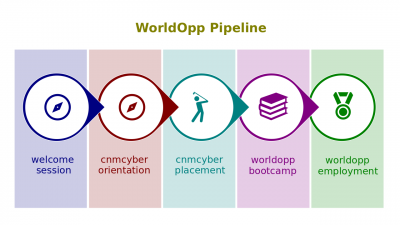Difference between revisions of "Sourcing Strategies"
(→Script) |
(→Script) |
||
| Line 11: | Line 11: | ||
===Script=== | ===Script=== | ||
| − | : | + | :[[Recruiter]]s must find the [[source]]s where they can find qualified [[employment candidate]]s. A look at internal sources would be at the beginning of most strategies. |
| − | : | + | :The internal sources of recruitment are the current [[employee]]s of the employing organization. The [[employer]] has already screened them and established [[employment relationships]]. |
| − | : | + | :When there is an [[opportunity]] for [[career progression]], the current ''employees'' may seize that ''opportunity''. When not, they may refer somebody in their networks. |
| − | :Most of [[employer]]s use [[in-network message]]s to find the ''sources''. These messages are sent to the [[employee]]s and those stakeholders who are in the organizational network. These messages contain the information about the [[employment vacancy]] and, possibly, about a [[referral fee]] | + | :Most of [[employer]]s routinely use [[in-network message]]s to find the ''sources''. These messages are sent to the [[employee]]s and those stakeholders who are in the organizational network. These messages contain the information about the [[employment vacancy]] and, possibly, about a [[referral fee]]. |
| − | : | + | :All in all, recruitment is neither cheap nor fast. Relying on the internal sources tends to save recruitment time and money. A referral from a current employee significantly simplifies screening and is a credential itself. |
| − | : | + | :When internal sources are not sufficient, ''recruiters'' may look for those [[worker]]s who are active on the ''market'', as well as those who are not. ''Employers'' may conduct [[vacancy marketing]] on their own or hire [[third-party recruiter]]s. |
| − | : | + | :Building reliable sources through partnerships may be another strategy. An ''employer'' may sponsor a professional group, [[vocational school]], or media in exchange for the leads and accesses to potential [[employment candidate]]s. |
'''[[Worker Competences]]''' is the successor [[lectio]]. | '''[[Worker Competences]]''' is the successor [[lectio]]. | ||
==Quiz== | ==Quiz== | ||
Revision as of 19:52, 10 May 2020
Sourcing Strategies (hereinafter, the Lectio) is the second lesson part of the Sourcing Essentials lesson that introduces its participants to employment vacancies and related topics.
This lesson belongs to the Introduction to Recruitment session of the CNM Cyber Orientation. The Orientation is the second stage of the WorldOpp Pipeline.
Contents
Content
The predecessor lectio is Position Requirements.
Key terms
- [[]].
Script
- Recruiters must find the sources where they can find qualified employment candidates. A look at internal sources would be at the beginning of most strategies.
- The internal sources of recruitment are the current employees of the employing organization. The employer has already screened them and established employment relationships.
- When there is an opportunity for career progression, the current employees may seize that opportunity. When not, they may refer somebody in their networks.
- Most of employers routinely use in-network messages to find the sources. These messages are sent to the employees and those stakeholders who are in the organizational network. These messages contain the information about the employment vacancy and, possibly, about a referral fee.
- All in all, recruitment is neither cheap nor fast. Relying on the internal sources tends to save recruitment time and money. A referral from a current employee significantly simplifies screening and is a credential itself.
- When internal sources are not sufficient, recruiters may look for those workers who are active on the market, as well as those who are not. Employers may conduct vacancy marketing on their own or hire third-party recruiters.
- Building reliable sources through partnerships may be another strategy. An employer may sponsor a professional group, vocational school, or media in exchange for the leads and accesses to potential employment candidates.
Worker Competences is the successor lectio.
